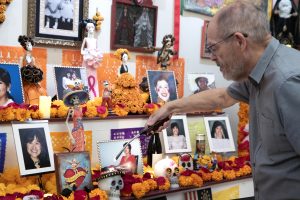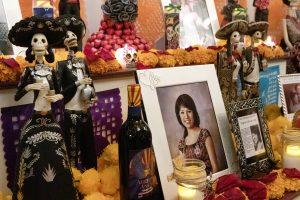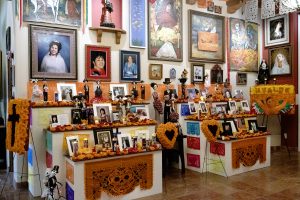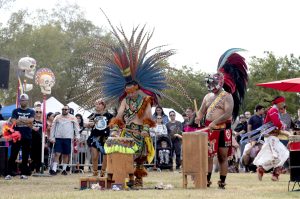- Slug: BC-CNS Dia de los Muertos Traditions, about 900 words. By Scianna Garcia.
- 7 photos available below.
- Video available.
By Scianna Garcia
Cronkite News
PHOENIX – Día de los Muertos is celebrated in Mexico and other Latin American countries in different ways, but with a common purpose – to celebrate those who have passed away.
The celebration, which takes place on Nov. 2 and the days leading up to it each year, is one of the most renowned traditions in Mexico and is a way to remember loved ones and invite their spirits back to earth by displaying their photos and favorite items, and leaving gifts and offerings at a personalized altar.
Some celebrate the Day of the Dead by honoring the traditions started by the Aztecs.
José Cárdenas of Chandler lost his wife, Virginia, 10 years ago and has since honored her memory with artwork throughout his home and a grand altar – or ofrenda – for Día de los Muertos.
“It’s a celebration of families, a remembrance of our roots and where we came from, and it’s particularly significant to me because of the passing of my wife,” Cárdenas said. “It was very important to my wife, so it’s important to me.”
Cárdenas builds ofrendas for his wife, parents, grandparents and relatives of his wife. Along with family altars, he builds a special one every year for a person or group of people who have died that year.
In 2020, he created one for the late Supreme Court Justice Ruth Bader Ginsburg and another for the 700,000 Americans who had died from COVID-19 at the time. This year, Cárdenas’ special ofrenda honors the 19 schoolchildren in Uvalde, Texas, who were murdered in a mass shooting in May.
Some years, including this one, the 69-year-old retiree holds open houses to allow close friends to see his altars firsthand. They share food and drinks, such as Abuelita brand hot chocolate, cajeta and pears – all favorites of his loved ones.
Aside from artwork, marigolds are essential to his altars, he said, as the Aztecs believed the scent attracts the souls of the dead.
He also hangs papel picado – a traditional Mexican paper crafted with elaborate designs that’s often used during Día de los Muertos celebrations – from the ceiling. The papel picado in Cárdenas home read “Uvalde” and “Virginia Eterno,” which means “Virginia everlasting.”
Cárdenas said he invites people into his home because he wants to share the tradition and meaning of Día de los Muertos.
“Some people think it’s the Mexican version of Halloween, but it’s not. It’s an Indigenous tradition that predates the conquest in remembrance of those who have passed away,” he said.
Carmen and Zarco Guerrero, director and art director of the Phoenix nonprofit Cultural Coalition, organized the 11th annual Mikiztli festival, an ancestral celebration of the Indigineous people of Mexico. Several hundred people attended Sunday’s celebration at Steele Indian School Park.
“Mikiztli goes back 3,000 years to the time of the Olmecs,” Zarco Guerrero said, referring to the earliest known Mesoamerican civilization. It is, he said, “truly a Mexican celebration.”
“There is no no other culture in the world that celebrates the theme like Mexico does with such pageantry, extravagance, passion, cynicism, sarcasm and humor,” he said.
Although most believe Día de los Muertos to be a two-day celebration, Zarco Guerrero said, it began as an entire season and wasn’t ever about death.
“It was about transcendence because there’s no word for death in the Nawat language. We didn’t die, we transcended and joined the spirits,” he said.
Nawat was spoken in several parts of Central America by the Uto-Aztecs, but only a few dozen speakers are alive today.
The Cultural Coalition has celebrated the holiday in metro Phoenix for more than 40 years.
“Here we are in 2022, when gentrification and commercialization has dominated the scene of Día de los Muertos, and that’s why we call ourselves Mikiztli,” Zarco Guerrero said. “We distinguish ourselves from the other Day of the Dead celebrations because we are decolonized.”
Carmen Guerrero said the Mikiztli festival offers a community altar because many people no longer live in the land of their ancestors.
“We’re very much a Mexican-centric celebration, but we open it up to other cultures to come and participate the best way they see fit, honoring their cultural traditions, as well as respecting the traditions of Mexico,” she said.
The Mikiztli also features a traditional Aztec dance, shared by members of the Native American community. One of the dances was the Huitzilopochtli, which signifies a hummingbird or spirit transition.
“We’re celebrating our Indigenous heritage of the profound legacy left to us by our Indigenous ancestors that we have forgotten because they’ve been obliterated from our consciousness, but we’re bringing that back through this celebration,” Zarco Guerrero said.
Maria Parra Cano, a Phoenix native of Indigienous and Mexican roots, is a part of the Mitotiliztli Huehuetlolli dance group, which shared the ancestral dance at the festival, with participants forming a circle around two drummers and coordinating steps to music from their instruments.
The group dressed in traditional attire, complete with a headdress and chachayotes – ankle rattle instruments decorated with beadwork and made from the seed of the yellow oleander tree.
Cano said the dance at the festival was a way to honor another group member’s mother, who had died Sunday morning.
“I’ve raised my kids with this tradition for the past 25 years,” she said. “We do what we can in our home altars to honor those who have passed. It adapts and changes per community, but most of the traditions are sustained.”
For more stories from Cronkite News, visit cronkitenews.azpbs.org.






